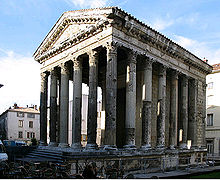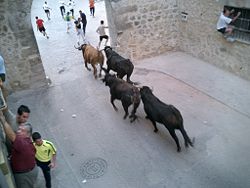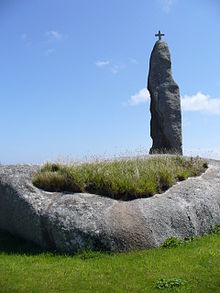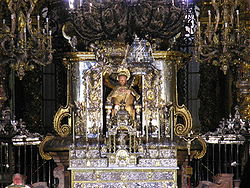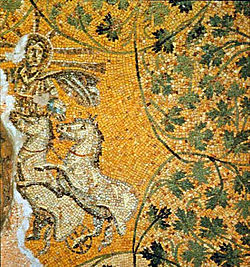- Christianised sites
-
The Temple of Augustus and Livia at Vienne, Isère, like the better known Maison Carrée at Nîmes, owes its survival to its conversion to a church

One aspect of Christianisation was the Christianisation of sites that had been pagan.[1] In the 1st centuries of Christianity churches were either house churches in whatever houses were offered for use by their owners, or were shrines on the burial-sites of martyrs or saints, which following the usual classical practice were invariably on the (then) edges of cities - the necropolis was always outside the polis. In Rome the early basilica churches of St. Peter's, Saint Paul Outside the Walls and San Lorenzo fuori le Mura, all follow this pattern. This distinction was gradually broken down, perhaps earliest in Roman Africa, as relics of the saints came to be kept in city-centre churches. By the 6th century bishops were often buried inside their cathedral, and other Christians followed.[2] After the Peace of the Church, the old pagan temples continued to function but gradually fell into disuse, and were finally all closed by the decrees of Theodosius I at the end of the 4th century. Initially they were shunned by Christians, perhaps because of their pagan associations, but also because their shape did not suit Christian requirements: "To the early Church, only one sort of building seemed suitable for christianization: the basilica", which had previously always been a secular type of building.[3] Some of these basilicas were private ones in the homes of wealthy Christians: examples include the 4th century foundations of San Lorenzo in Damaso and the Basilica di San Clemente. Eventually the prime sites of the pagan temples were very often occupied for churches, the church of Santa Maria sopra Minerva (literally Saint Mary above Minerva) in Rome, Christianized about 750, being simply the most obvious example. However this process did not really begin in Rome itself until the 6th and 7th centuries, and was still under way during the Renaissance, when the Pantheon was made a church and Santa Maria degli Angeli e dei Martiri and San Bernardo alle Terme made from parts of the enormous Baths of Diocletian.[4]
By the 7th century attitudes had changed and missionaries to the barbarian nations enthusiastically turned pagan sites immediately over to church use. Sulpicius Severus, in his Vita of Martin of Tours, a dedicated destroyer of temples and sacred trees, remarks "wherever he destroyed heathen temples, there he used immediately to build either churches or monasteries" (Vita, ch xiii), and when Benedict took possession of the site at Monte Cassino, he began by smashing the sculpture of Apollo and the altar that crowned the height. Montmartre was the site of one of the oldest surviving Christian churches in France - Saint Pierre, and where the Jesuit movement was supposedly founded, was earlier a mercurii monte - a high place dedicated to Lugus, a major Celtic deity (and one that the Romans viewed as a homology of Mercury).
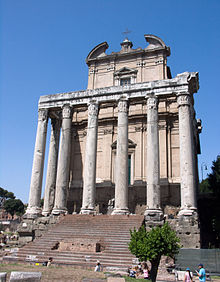 Selective conservation of pagan sites: San Lorenzo in Miranda occupies the Temple of Antoninus and Faustina, Rome, conserving the pronaos
Selective conservation of pagan sites: San Lorenzo in Miranda occupies the Temple of Antoninus and Faustina, Rome, conserving the pronaos
In Francia, the site chosen for the abbey of Luxueil were the ruins of a well-fortified Gallo-Roman settlement, Luxovium, that had been ravaged by Attila in 451, and was now buried in the dense overgrown woodland that had filled the abandoned site over more than a century; the place still had the advantage of the thermal baths ("constructed with unusual skill", according to Columbanus' early biographer, Jonas of Bobbio) down in the valley, which still give the town its name of Luxeuil-les-Bains. Jonas described it further: "There stone images crowded the nearby woods, which were honoured in the miserable cult and profane former rites in the time of the pagans".[5] With a grant from an officer of the palace at Childebert's court, an abbey church was built with a sense of triumph within the heathen site and its "spectral haunts".[6]
In country places and among country people (pagani) as Jean Seznec observes[7] euhemerist dismissal by Christian writers of pagan deities as once having been human was insufficient cause to abandon old ways: "in country districts, the chief obstacle to Christianity was offered by the tenacious survival of anthropomorphic cults; here the problem became one of still further humanizing the divinities of springs, trees and mountains, in order to rob them of their prestige". In Britain and the Celtic northwest of Europe, the divinities of springs were transformed into local saints who were often venerated only at the location of their "holy well".
The conversion of pre-Christian places of worship, rather than their destruction, was particularly true of temples of Mithras, a religion that had been the main rival to Christianity during the 2nd and 3rd centuries, especially among the Roman legions. In Rome the early titular churches, each protected by a patron, were sometimes adapted from the basilica, or auidience hall, of a prominent man's domus.
During the Reconquista and the Crusades, the cross served the symbolic function of physical possession that a flag would occupy today. At the siege of Lisbon in 1147, when a mixed group of Christians took the city, "What great joy and what a great abundance there was of pious tears when, to the praise and honor of God and of the most Holy Virgin Mary the saving cross was placed atop the highest tower to be seen by all as a symbol of the city's subjection."[8]
Contents
Britain and Northern Europe
In Britain, the legendary King Lucius, was reported by Geoffrey of Monmouth, the often unreliable Christian chronicler, to have deliberately converted all the old temples to churches. The historical actuality is nowhere more forthrightly discussed than in the famous letter from Pope Gregory I to Mellitus, about to join Augustine of Kent among the Anglo-Saxons:
- So when almighty God has led you to the most reverend man our brother Bishop Augustine, tell him what I have long gone over in my mind concerning the matter of the English: that is, that the shrines of idols amongst that people should be destroyed as little as possible, but that the idols themselves that are inside them should be destroyed. Let blessed water be made and sprinkled in these shrines, let altars be constructed and relics placed there: since if the shrines are well built it is necessary that they should be converted from the worship of demons to the service of the true God, so that as long as that people do not see their very shrines being destroyed they may put out error from their hearts and in knowledge and adoration of the true God they may gather at their accustomed places more readily.
Though such openness about the history of church locations was often expressed, such claims about more significant church locations were often more controversial. The Notre-Dame du Taur (Our Lady of the Bull), cathedral church of Toulouse, which according to Christian tradition was founded where a bull stopped running, and is famous for the Encierro festival of running bulls, is thought by archaeologists to possibly be a converted temple of Mithras, whose myth focused on the tauroctony, the probably-astrological killing of a sacred bull.
The British Isles and other areas of northern Europe that were formerly druidic are still densely punctuated by holy wells and holy springs that are now attributed to some saint, often a highly local saint unknown elsewhere. These water sources have always been guarded by supernatural forces in the European imagination. An example of the pre-Christian water spirit is the melusina. As the official Catholic Church expanded its requirements for Christian baptisteries in the 5th and 6th centuries, sacred pagan springs presented natural opportunities. Historically some bath houses and pagan springs were forcibly seized. Cassiodorus, the courtly secretary to the Ostrogoth Theodoric the Great, described in a letter written in A.D. 527, a fair held at a former pagan shrine of Leucothea, in the still culturally Greek region of south Italy, which had been Christianized by converting it to a baptistery (Variae 8.33). In a paper read in 1999, Samuel J. Barnish drew further examples of the transition from miraculous springs to baptisteries from Gregory of Tours (died c. 594) and Maximus, Bishop of Turin (died c. 466).
The great Abbey of Luxeuil founded by Saint Columban had its origins in a Gallo-Roman villa that had been ravaged by Attila in 451, and was now buried in the dense overgrown woodland that had filled the abandoned site over more than a century. However, the place still had the advantage of the thermal baths "constructed with unusual skill", as Columban's early biographer, Jonas of Bobbio reported. He further added that, down in the valley, which still gives the town its name Luxeuil-les-Bains, "stone images crowded the nearby woods, which were honored in the miserable cult and profane former rites in the time of the pagans," the monk Jonas records. (Ibi imaginum lapidearum densitas vicina saltus densabat, quas cultu miserabili rituque profano vetusta Paganorum tempora honorabant) [4]. With a grant from an officer of the palace at Childebert's court, an abbey church was built with a sense of triumph within the heathen site and its spectral haunts (ut, ubi olim prophano ritu veteres coluerunt fana, ibi Christi figerentur arae et erigerentur vexilla, habitaculum Deo militantium, quo adversus aërias potestates dimicarent superni Regis tirones).
In Britain and many other parts of Europe trees were also sometimes seen as sacred or the home of tree spirits. When Britain was Christianised this resulted in a change of the landscape. In some instances sacred groves were destroyed to discourage belief in tree spirits. One of the most famous of these was the Irminsul, whose ancient location is no longer known (though it may have been located at Externsteine), was obliterated by Charlemagne. Another major ancient holy tree was Thor's Oak, which was deliberately desecrated and destroyed by a Christian missionary named Winfrid (later canonised as Saint Boniface).
Greece
In Greece, the occupation of pagan sites by Christian monasteries and churches was ubiquitous.[9] Hellenic Aphrodisias in Caria was renamed Stauropolis, the "City of the Cross".[10]
Iberia
Santiago de Compostela is a major site of Christian pilgrimage, and said in Christian tradition to originate as the burial place of Saint James the Great; pilgrims traditionally follow the Way of St. James until they reach the Cathedral, but then, having visited the church, continue to Cape Finisterre. The continuation to Cape Finisterre is regarded by historians as unjustifiable for Christian reasons, but Finisterre has a prominent pre-Christian significance, it was considered to literally be the edge of the world (hence the name finisterre, meaning end of the world), due to it seeming to be the westernmost point of Europe (in reality, even though it juts out to the west, the more subtle Cabo da Roca holds the honour). In pre-Christian times, the souls of the dead were believed to trace their way across all Europe to Finisterre and follow the sun across the sea, and their route, the Santa Compaña, became a significant pilgrimage throughout south western Europe. Santiago de Compostela itself was held to be the place where the dead gathered together, and where their paths finally all joined together for the final stretch of the journey; one possible etymology of Compostela is burial ground, suggesting that even the name derives from the pre-Christian belief. To historians, the church was put in place to divert the pilgrims to Christianity, rather than the pilgrimage coming after the church.
Rome
In Rome itself, numerous buildings including pagan temples and other sites were converted into churches, and several major archeological sites owe their survival to this. On the Roman Forum alone, the Curia Iulia or Roman Senate building (Sant'Adriano in Foro), the Temple of Antoninus and Faustina (San Lorenzo in Miranda), and the Temple of Romulus (Santi Cosma e Damiano) were transformed into churches, and the churches of San Giuseppe dei Falegnami and San Pietro in Carcere were built above the Mamertine Prison nearby, where Sts. Peter and Paul were reputed to have been held. The previously mentioned Pantheon and Baths of Diocletian were also converted into churches.
one of the most richly adorned churches, the Basilica di San Clemente, was, according to Christian tradition, built on top of Titus Flavius Clemens's private home, as he had allowed early Christians to worship in his home, due to having pro-Jewish sympathies. An early 2nd century Mithraeum stands across the Roman street from the house and can be visited by visitors. Other Mithraea have been excavated under churches, such as Santa Prisca, and Santo Stefano Rotondo.
Several churches, especially in Rome, are said to have been built on the sites of the earlier burial places of martyrs in the catacombs of Rome or elsewhere. The sanctification of burial places, and placing tombs inside churches, was a novelty of Christianity, and a break with pagan tradition, where burials were regarded as unclean, and usually only allowed beyond a set distance from a city's walls.
The Vatican
St. Peter's Basilica, the church of the Vatican, is traditionally located at the burial place of Simon Peter, and most parties, including the Roman Catholic Church, agree that the basilica was built on top of a large necropolis on the Vatican Hill. In 1939, an excavation underneath the grottoes which lie directly under the current Basilica, uncovered several surviving Roman mausoleums from the necropolis, and in the area directly under the high altar, below the grottoes, the excavators found a structure resembling a temple that they named the aedicula (meaning little temple). According to the official vatican sanctioned report, underneath the aedicula the 1939 excavation uncovered an empty grave, and, where the grave went under a red wall, they found a set of bones that the vatican claims were Simon Peter's, since they had been able to find a nearby graffito which the vatican states said that peter is inside. These archaeological remains are now pointed out on private tours of the necropolis excavation site as being the original .
Catholic sources frequently cite the official Vatican report verbatim. The Vatican sanctioned expedition has, however, been heavily criticised by non-Catholic sources for its lack of scholarly behaviour:
- the entire excavation was kept secret for 10 years, 4 years beyond the end of the Second World War.
- the excavators were Jesuits
- the critical scholar involved in checking the bones was only allowed to do so on condition that they did not publish the results
- the bones were found only when the pope himself was at the site
- the excavation was destructive to the aedicula floor, and insufficient notes were kept, such that it is now impossible for independent archaeologists to verify how much of the findings are genuine
- the graffito was found when it suddenly appeared a few days after the find of the bones when they started looking for a connection to Simon Peter.
One of the few critical scholars to have assessed the bones, came to the conclusion that they cannot be Simon Peter's, at least not all of them, as there are 5 leg bones, requiring at least 5 legs, and that the collection of bones also includes animal remains as would be found from food (chicken bones, etc.), making it strange for them to have been found collected together into a small pile and pushed under a wall in an otherwise empty grave. More tellingly, the soil attached to the bones appears not to come from the empty grave, suggesting that they did not actually lie there, and leading sceptical scholars to suggest that the bones had actually been collected by the excavators from around the necropolis, and only grouped together by vatican officials, with heavily sceptical scholars arguing that the vatican officials were deliberately committing fraud, to explain why there seemed to be a temple under the high altar.
The graffito itself is more ambiguous than the vatican conclusion would appear; several letters are missing, and though the vatican concludes that it states petr[os] en[i], meaning peter is inside, the gap between en and what seems to be an i is rather large, and several scholars have suggested that the text actually states petr[os] en[dei], meaning peter is not inside - a warning against mistaking the location for Simon Peter's grave; another alternative possibility for the text, according to scholars, is petr[o] [g]en[es], meaning rock-born, which would be a direct reference to Mithras, and suggesting that the aedicula was quite literally a mini-temple.[11] The graffito itself was found on a piece of plaster, that supposedly, according to the vatican, had broken from a nearby wall in such a way that it is no longer possible to tell which part it came from, making it near impossible to tell whether the missing parts of the text are still in place and readable. Sceptics have argued that this is excessively convenient for the vatican, and some have even argued that it was deliberately broken from the wall so that what it originally said could not be seen.[12]
Most of the rediscovered tombs in the necropolis under the Basilica are demonstrably non-Christian, but among those that appear to be Christian, is one which depicts Sol Invictus, using the same clear iconography as other Sol Invictus images, but identifies it as a Christian image, identifying Sol Invictus to be the same individual as Jesus.
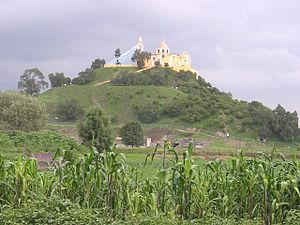 Nuestra Señora de los Remedios doesn't efface the Great Pyramid of Cholula, Mexico.
Nuestra Señora de los Remedios doesn't efface the Great Pyramid of Cholula, Mexico.
The New World
Few Native American sites in North America could compare with the pyramid temples of Mexico and Central America. Often the Christianized site in Spanish America gives no indication of its former use, as at the site of a pyramid shrine to the god Huitzilopochtli that was dismantled to provide stone for the Franciscan monastery that now houses the Museo Nacional de las Intervenciones.
See also
- Germanic Christianity for the Christianization of the Germanic peoples
- Christianisation
- The Christianised calendar
- Christianised Myths and Imagery
- Christianised rituals
- Summit cross
Notes
- ^ This is not solely a feature of Christianity, needless to say; the phenomenon was discussed in broader terms by F.W. Hasluck, Christianity and Islam under the Sultans (Oxford) 1929.
- ^ Williams, 56-59
- ^ Syndicus, 39
- ^ Sindacus, 39, although the Basilica of Junius Bassus was made a church in the late fifth century
- ^ Ibi imaginum lapidearum densitas vicina saltus densabat, quas cultu miserabili rituque profano vetusta Paganorum tempora honorabant [1].
- ^ ut, ubi olim prophano ritu veteres coluerunt fana, ibi Christi figerentur arae et erigerentur vexilla, habitaculum Deo militantium, quo adversus aërias potestates dimicarent superni Regis tirones [2].
- ^ Seznec, The Survival of the Pagan Gods, (B.F. Sessions, tr.) 1995:13 note 8.
- ^ De expugnatione Lyxbonensi (On-line text)
- ^ A detailed discussion is in T. Gregory, "the survival of paganism in Christian Greece", American Journal of Philology 107 (1986:229-42).
- ^ See R.S. Cormack, "The temple as the cathedral" in C. Roueché and K.T. Erim. eds. Aphrodisias Papers: Recent Work on Architecture and Sculpture, Journal of Roman Archaeology supplement (Ann Arbor 1990:75-88).
- ^ A sketch of the exact graffito in question, as found, and its possible readings, is available at [3]
- ^ ibid
References
- Curran, John 2000. Pagan City and Christian Capital. (Oxford) ISBN 0-19-815278-7. Reviewed by Fred S. Kleiner in Bryn Mawr Classical Review 20
- Kaplan, Steven 1984 Monastic Holy Man and the Christianization of Early Solomonic Ethiopia (in series Studien zur Kulturkunde) ISBN 3-515-03934-1
- Kerenyi, Karl, Dionysus: Archetypal Image of Indestructible Life 1976.
- MacMullen, Ramsay, Christianizing the Roman Empire, AD 100 – 400 Yale University Press (paperback, 1986 ISBN 0-300-03642-6)
- Syndicus, Eduard; Early Christian Art; Burns & Oates, London, 1962
- Trombley, Frank R., 1995. Hellenic Religion and Christianization c. 370-529 (in series Religions in the Graeco-Roman World) (Brill) ISBN 90-04-09691-4
- Vesteinsson, Orri, 2000. The Christianization of Iceland: Priests, Power, and Social Change 1000-1300 (Oxford:Oxford University Press) ISBN 0-19-820799-9
- Williams, Mark F., The making of Christian communities in Late Antiquity and the Middle Ages, Anthem Press, 2005, ISBN 1898855773, 9781898855774, google books
External links
- Jorge Quiroga and Monica R. Lovelle, "Ciudades atlánticas en transición: La “ciudad” tardo-antigua y alto-medieval en el noroeste de la Península Ibérica (s.V-XI)" from Archeologia Medievale vol xxvii (1999), pp 257–268 Christianizing Late Antique Roman sites from the 6th century onwards.
- Sceptical account of the remains under St Peter's Basilica
- Catholic apologist account of the remains under St Peter's Basilica
Categories:- Cultural assimilation
- Christianity and other religions
- Christian sites of the Roman Empire
- Christianity and Paganism
- Conversion of non-Christian places of worship into churches
Wikimedia Foundation. 2010.

